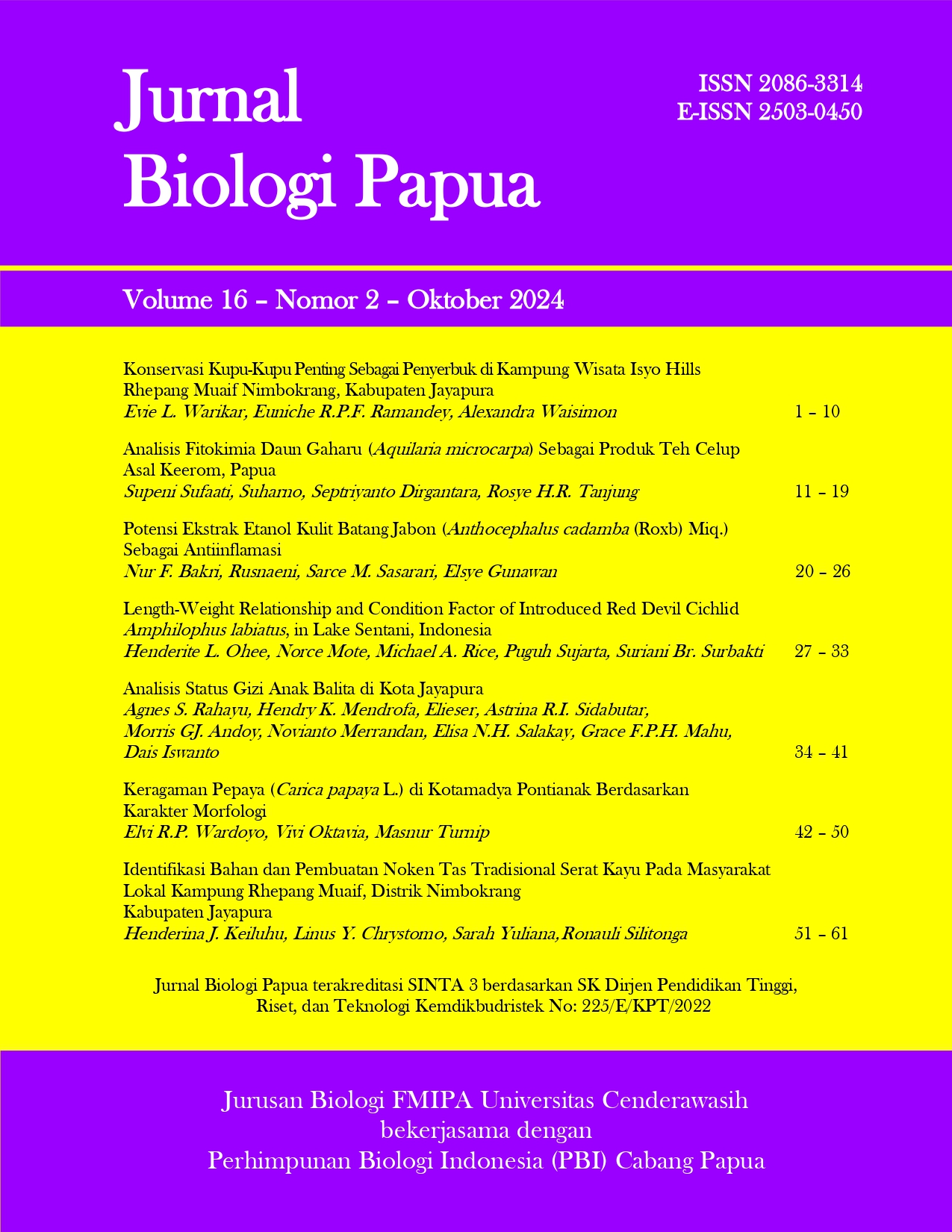Konservasi Kupu-Kupu Penting Sebagai Penyerbuk di Kampung Wisata Isyo Hills Rhepang Muaif Nimbokrang, Kabupaten Jayapura
https://doi.org/10.31957/jbp.3575
Keywords:
conservation, butterfly , pollinators, Rhepang MuaifAbstract
Butterflies are an important example of pollinating insects of the Order Lepidoptera. The presence of butterfly pollinating insects in nature is highly dependent or influenced by the availability of flowering plants visited in the ecosystem. The purpose of this study was to determine the diversity and abundance of butterfly pollinator in flowering plants. A direct survey method (visual) with a radius of ± 100-250 m² was done with scan sampling technique. Parameters measured were the abundance and the species richness of butterflies visited flowering plants as well as the species richness of flowering plants visited by butterflies pollinator. The data obtained were analyzed using the the Shannon-Wiener diversity index (H’). The results showed that at study sites in secondary forest habitats and yards, 25 species of butterfly pollinators were found consisting of 5 families with 308 individuals. Nine species of flowering plants visited by butterfly pollinators. The Jatropha integerrima was the most visited by butterfly pollinators with 11 species, followed by Hibiscus rosa-sinensis and Ixora coccinea (9 species), Clerodendron paniculatum (6 species), Mussaenda ralateensis (4 species), Bidens pilosa and Celosia argentea (3 species), Zinnia elegans visited by 2 species and Portulaca oleracea visited by 1 species of butterfly pollinators. Based on the calculation, the value of Shannon-Wiener index (H') is 2.946, which indicates that the level of diversity of butterfly pollinators in the medium category.
Downloads
References
Allifah, A.N., F. Bahalwan, dan N.A Natsir. 2020. Keanekaragaman dan kelimpahan serangga polinator pada perkebunan mentimun (Cucumis sativus L) Desa Waiheru Ambon. Jurnal Biology Science & Education Biologi Sel. 9(1): 26 – 34.
Amrullah, S.H., Hilda, dan R.F. Rusli. 2018. Identifikasi lebah dan kupu polinator di Hutan Billa Battang Kota Palopo. Jurnal Dinamika. 9(2): 1-12.
Chung, A.Y.C., P. Eggleton, M.R. Speight, P.M. Hammond and V.K. Chey. 2000. The diversity of Beetle assemblages in different habitat types in Sabah, Malaysia. Bulletin of Entomological Research. 90: 475–496.
Chowdhury, S., V.K. Dubey, S. Choudhury, A. Das, D. Jeengar, B. Sujatha, A. Kumar, N. Kumar, A. Semwal and V. Kumar. 2023. Insects as bioindicator: A hidden gem for environmental monitoring. Frontier in Environment Science. 11: 1-16. doi: 10.3389/fenvs.2023.1146052.
Corlett, R.T., 2004. Flower visitors and pollination in the Oriental (Indomalayan) Region. Biological Review (79): 497-532.
Badan Pusat Statistik (BPS) Distrik Nimbokrang. 2020. Distrik Nimbokrang dalam angka. BPS Kabupaten Jayapura.
Hidayat, P. A., H. Pratiknyo dan E. Basuki. 2016. Keragaman serangga polinator pada tumbuhan Edelweiss Jawa (Anaphalis javanica) di Gunung Slamet Jawa Tengah. Seminar Nasional Pendidikan dan Saintek.
Insafitri. 2010. Keanekaragaman, keseragaman, dan dominansi Bivalvia di Area Buangan Lumpur Lapindo muara sungai Porong. Jurnal Kelautan. 3(1): 54-59.
Kantartzi, M.K., D.N. Milonas, C.Th. Buchelos and D.N. Avtzis. 2010. How does pollution affect Insect diverity? A study on bark beetle entomofaune of two pine forests in Greece. Journal of Biological Research-Thessaloniki. 13: 67-74.
Levetin, E., and K.Mc. Mahon. 1999. plant and society. Second Edition. Mc Graw-Hill Inc. New York.
Masawet S., R.Koneri, dan F.N.J. Dapas 2019. Keanekaragaman serangga penyerbuk di perkebunan sayuran Kelurahan Rurukan Kota Tomohon. Jurnal Bioslogos. 9: 111-118.
Mas’ud A., A.D. Corebima A. Haerullah, S. Hasan, dan Alisi. 2019. Jenis kupu-kupu pengunjung bunga Mussaenda dan Asoka di Kawasan Cagar Alam Gunung Sibela Pulau Bacan. Jurnal Biologi Tropis. 19(2): 189-196.
Müller. N., J. Rathgens, R. Fletcher, and S. Hilser. 2023. Linking tourism and conservation on privately owned natural areas: A systematic review of English-language literature. Society & Natural Recourches. 36 (3): 306–325.
Ngatimin S.N.A., T. Abdullah, A. Nasruddin, dan Fatahuddin. 2019. Konservasi kupu-kupu sebagai serangga penyerbuk yang penting di Taman Nasional Bantimurung-Bulusaraung. Jurnal Penelitian Kehutanan Bonita. 1 (2): 10-14.
Odum, E.P. 1993. Dasar-dasar ekologi. Penerjemahan: Samingan, T dan B. Srigandono. Gajahmada University Press. Yogyakarta.
Parsons, M. 1999. The butterflies of Papua New Guinea (Their Systematics & Biology). Academic Press. London.
Rahayu, S.K., Supriyadi, Supriyono, R. Wijayanti, dan R.B.A. Putri. 2018. Keanekaragaman serangga pengunjung bunga pada tanaman tumpang dari kedelai dengan Tanaman Orok-Orok (Crotalaria Juncea). Jurnal Entomologi Indonesia. 15(1): 23–30.
Ruslan, H., Yenisbar, and A. Satiyo. 2023. Correlation of butterfly (Lepidoptera: Papillionoidea) with flowering plant In the Bodogol Nature Conservation Education Center, Mount Gede Pangrango. Journal of Tropical Biodiversity. 3 (2): 1–13.
van Mastrigt, H., dan E. Rosariyanto. 2013. Buku Panduan Lapangan Kupu-kupu untuk Wilayah Mamberamo sampai Pegunungan Cyclops. Conservation International, Jakarta.
van Steenis, C.G.G.J., 1988. Flora. PT. Pradnya Paramitha. Jakarta.













